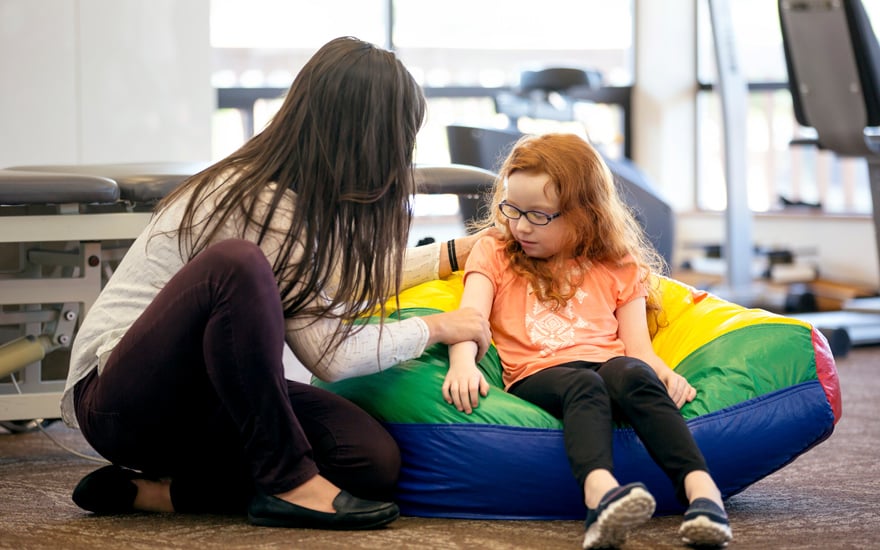
Amplified musculoskeletal pain syndrome, or AMPS, is a chronic condition in which a person feels more intense pain than expected. Children with AMPS can have a spectrum of muscle, bone, or joint pain anywhere in the body. The condition can be challenging for children, for whom pain may be worse than for adults. It is one of the most frequent reasons children seek pain relief treatment.
How Does AMPS Occur?
Normally, a pain signal from an injury or other stimulus travels up to the brain from the injury site. In AMPS, the pain signal also goes to the neurovascular nerves (known as the fight or flight nerves) that control blood flow. The body reacts by causing the blood vessels to constrict, reducing blood flow and oxygen to muscles and bones. When this happens, a build-up of waste products, such as lactic acid occurs, causing pain. As this cycle continues, a further decrease in blood flow leads to even more pain or amplified pain.
The exact cause of AMPS is not well understood. Research suggests that it may result from a problem with the delivery of the pain signal and the central nervous system. An injury may trigger the condition, and there may be a genetic component.
Children may be diagnosed with problems that fall under the AMPS umbrella, including conditions such as:
- Some genetic disorders.
- Juvenile fibromyalgia.
- Central sensitization disorders (a hypersensitivity to things that usually don't cause pain).
- Generalized chronic pain.
The following factors, when combined, can lead to AMPS:
- Injury.
- Illness.
- Psychological stress.
Children with AMPS may experience pain that is:
- In one area or widespread.
- Sudden or that comes on gradually.
- Constant or intermittent.
- Without a known cause.
- Triggered by stress, illness, or prior injury that continues beyond the typical healing time frame.
- Described as achy, dull, sharp, shooting, burning, throbbing, or stabbing.
- More intense than expected for a minor injury or event. For example, a child can perceive pain due to light touch, pressure, or changes in temperature.
- Limiting their ability to function or take part fully in daily activities.
Children with AMPS may miss school more often or become less active in their sport. They also may lack interest in social activities. In some children, AMPS can lead to significant functional disability.
Signs and Symptoms
In addition to the possible pain symptoms above, children with AMPS can have:
- Impaired muscle endurance and weakness.
- Poor cardiopulmonary (aerobic) endurance.
- Poor posture.
- Decreased function (the ability to do daily activities or meet one's own basic needs).
- Skin changes, such as swelling, temperature, or color changes.
- Elevated heart rate or blood pressure.
- Problems with balance or walking due to pain and lack of activity.
Other common symptoms linked to AMPS may include:
- Headache.
- Blurry vision.
- Memory problems.
- Chest pain.
- Feelings that the heart is racing, fluttering, or pounding.
- Dizziness.
- Stomach pain.
- Nausea and/or vomiting.
- Diarrhea or constipation.
- Abnormal movements of the arms or legs.
- Trouble sleeping.
- Fatigue.
How Can Physical Therapy Help Children with AMPS?
The goal of physical therapy and other treatment for people with AMPS is to break the pain cycle and restore quality of life. AMPS treatment often involves a team approach that includes physical and psychological therapists and physicians. Your physical therapist can work with your other health care providers to ensure comprehensive treatment.
Physical therapists work one-on-one with patients and their caregivers. They educate you about your condition and teach exercises designed to decrease your fear of movement. Physical therapists also can provide exposure-based treatments to help desensitize painful areas. They help people with AMPS shift their focus from pain to achieving function and teach ways to manage stress.
Your physical therapists will design a treatment program based on your needs and goals. A physical therapy treatment plan may include:
- Exercise therapy. Your physical therapist may teach you daily strength-building and aerobic exercises designed to:
- Retrain your body and help you gain the endurance, strength, and mobility needed to function and do daily activities.
- Reduce stress and decrease the afear of movement.
- Benefit your nervous system.
- Enable you to work through pain and discomfort.
- Help you learn how to move without pain.
- Address specific problems such as weakness, decreased balance, or difficulty walking.
- Desensitization. This type of therapy can help the body and tissues become less sensitive to pain or events that cause pain. It includes relaxation techniques and graded exposure to stimuli. Daily, progressive exposure can help retrain your nervous system. This can improve how the nerves respond to light touch, pressure, vibration, and temperature.
- Stress education. Your physical therapist may recommend that you seek counseling services. They also can teach you specific methods to manage stress, including:
- Relaxation techniques.
- Breathing exercises to help you relax.
- Mindfulness training.
- Strategies for self-regulation (the ability to monitor and manage your energy, emotions, thoughts, and responses to things that cause pain).
- Retraining your brain to pay less attention to pain. Your physical therapist can educate you on ways to limit how often you think and talk about pain. They can work with you to minimize your use of pain in your decision-making. This retraining can help reduce the importance your brain gives to pain so you can focus on and return to normal daily activities.
Physical therapists are movement experts who use the best available evidence to design treatment plans for each person's needs and goals. They use hands-on care, patient education, and prescribed exercise.


